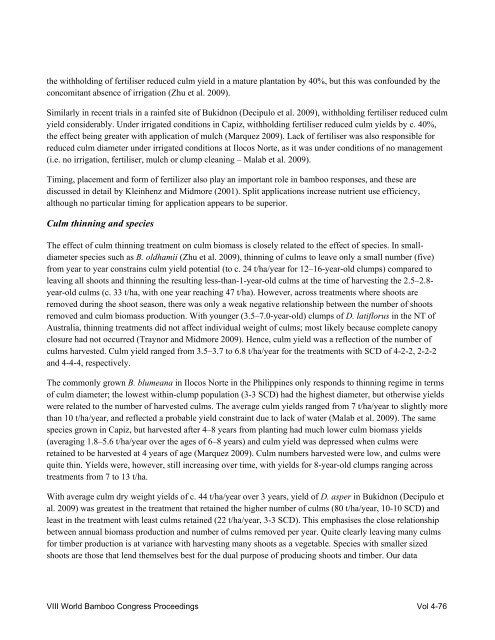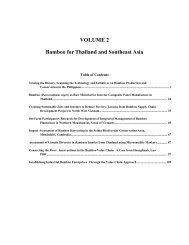WBC-VIII-Vol.4 – Resources – Forestry, Plantations and ... - BambuSC
WBC-VIII-Vol.4 – Resources – Forestry, Plantations and ... - BambuSC
WBC-VIII-Vol.4 – Resources – Forestry, Plantations and ... - BambuSC
You also want an ePaper? Increase the reach of your titles
YUMPU automatically turns print PDFs into web optimized ePapers that Google loves.
the withholding of fertiliser reduced culm yield in a mature plantation by 40%, but this was confounded by the<br />
concomitant absence of irrigation (Zhu et al. 2009).<br />
Similarly in recent trials in a rainfed site of Bukidnon (Decipulo et al. 2009), withholding fertiliser reduced culm<br />
yield considerably. Under irrigated conditions in Capiz, withholding fertiliser reduced culm yields by c. 40%,<br />
the effect being greater with application of mulch (Marquez 2009). Lack of fertiliser was also responsible for<br />
reduced culm diameter under irrigated conditions at Ilocos Norte, as it was under conditions of no management<br />
(i.e. no irrigation, fertiliser, mulch or clump cleaning <strong>–</strong> Malab et al. 2009).<br />
Timing, placement <strong>and</strong> form of fertilizer also play an important role in bamboo responses, <strong>and</strong> these are<br />
discussed in detail by Kleinhenz <strong>and</strong> Midmore (2001). Split applications increase nutrient use efficiency,<br />
although no particular timing for application appears to be superior.<br />
Culm thinning <strong>and</strong> species<br />
The effect of culm thinning treatment on culm biomass is closely related to the effect of species. In smalldiameter<br />
species such as B. oldhamii (Zhu et al. 2009), thinning of culms to leave only a small number (five)<br />
from year to year constrains culm yield potential (to c. 24 t/ha/year for 12<strong>–</strong>16-year-old clumps) compared to<br />
leaving all shoots <strong>and</strong> thinning the resulting less-than-1-year-old culms at the time of harvesting the 2.5<strong>–</strong>2.8year-old<br />
culms (c. 33 t/ha, with one year reaching 47 t/ha). However, across treatments where shoots are<br />
removed during the shoot season, there was only a weak negative relationship between the number of shoots<br />
removed <strong>and</strong> culm biomass production. With younger (3.5<strong>–</strong>7.0-year-old) clumps of D. latiflorus in the NT of<br />
Australia, thinning treatments did not affect individual weight of culms; most likely because complete canopy<br />
closure had not occurred (Traynor <strong>and</strong> Midmore 2009). Hence, culm yield was a reflection of the number of<br />
culms harvested. Culm yield ranged from 3.5<strong>–</strong>3.7 to 6.8 t/ha/year for the treatments with SCD of 4-2-2, 2-2-2<br />
<strong>and</strong> 4-4-4, respectively.<br />
The commonly grown B. blumeana in Ilocos Norte in the Philippines only responds to thinning regime in terms<br />
of culm diameter; the lowest within-clump population (3-3 SCD) had the highest diameter, but otherwise yields<br />
were related to the number of harvested culms. The average culm yields ranged from 7 t/ha/year to slightly more<br />
than 10 t/ha/year, <strong>and</strong> reflected a probable yield constraint due to lack of water (Malab et al. 2009). The same<br />
species grown in Capiz, but harvested after 4<strong>–</strong>8 years from planting had much lower culm biomass yields<br />
(averaging 1.8<strong>–</strong>5.6 t/ha/year over the ages of 6<strong>–</strong>8 years) <strong>and</strong> culm yield was depressed when culms were<br />
retained to be harvested at 4 years of age (Marquez 2009). Culm numbers harvested were low, <strong>and</strong> culms were<br />
quite thin. Yields were, however, still increasing over time, with yields for 8-year-old clumps ranging across<br />
treatments from 7 to 13 t/ha.<br />
With average culm dry weight yields of c. 44 t/ha/year over 3 years, yield of D. asper in Bukidnon (Decipulo et<br />
al. 2009) was greatest in the treatment that retained the higher number of culms (80 t/ha/year, 10-10 SCD) <strong>and</strong><br />
least in the treatment with least culms retained (22 t/ha/year, 3-3 SCD). This emphasises the close relationship<br />
between annual biomass production <strong>and</strong> number of culms removed per year. Quite clearly leaving many culms<br />
for timber production is at variance with harvesting many shoots as a vegetable. Species with smaller sized<br />
shoots are those that lend themselves best for the dual purpose of producing shoots <strong>and</strong> timber. Our data<br />
<strong>VIII</strong> World Bamboo Congress Proceedings Vol 4-76




